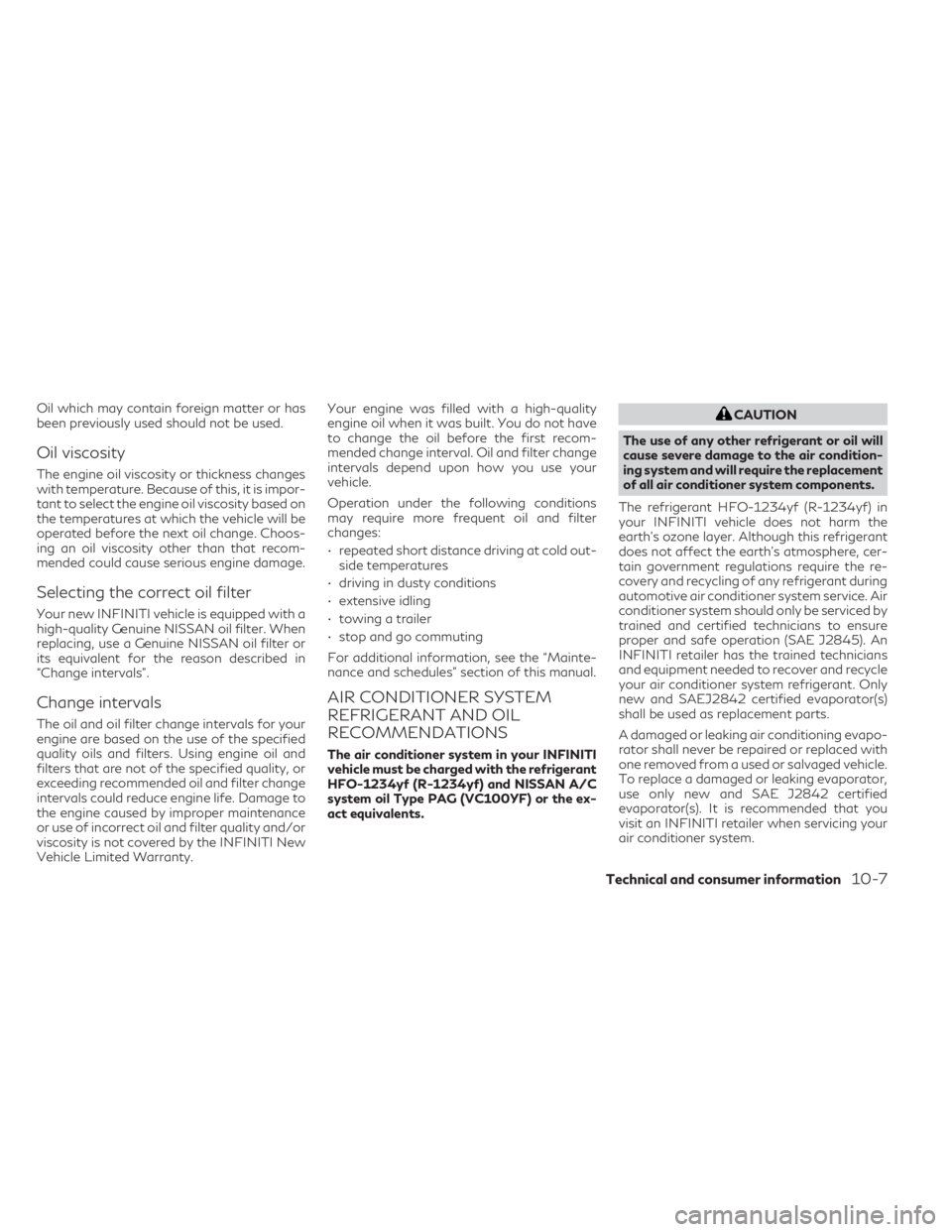service interval INFINITI QX60 2023 User Guide
[x] Cancel search | Manufacturer: INFINITI, Model Year: 2023, Model line: QX60, Model: INFINITI QX60 2023Pages: 636, PDF Size: 7.28 MB
Page 591 of 636

Oil which may contain foreign matter or has
been previously used should not be used.
Oil viscosity
The engine oil viscosity or thickness changes
with temperature. Because of this, it is impor-
tant to select the engine oil viscosity based on
the temperatures at which the vehicle will be
operated before the next oil change. Choos-
ing an oil viscosity other than that recom-
mended could cause serious engine damage.
Selecting the correct oil filter
Your new INFINITI vehicle is equipped with a
high-quality Genuine NISSAN oil filter. When
replacing, use a Genuine NISSAN oil filter or
its equivalent for the reason described in
“Change intervals”.
Change intervals
The oil and oil filter change intervals for your
engine are based on the use of the specified
quality oils and filters. Using engine oil and
filters that are not of the specified quality, or
exceeding recommended oil and filter change
intervals could reduce engine life. Damage to
the engine caused by improper maintenance
or use of incorrect oil and filter quality and/or
viscosity is not covered by the INFINITI New
Vehicle Limited Warranty.Your engine was filled with a high-quality
engine oil when it was built. You do not have
to change the oil before the first recom-
mended change interval. Oil and filter change
intervals depend upon how you use your
vehicle.
Operation under the following conditions
may require more frequent oil and filter
changes:
• repeated short distance driving at cold out-
side temperatures
• driving in dusty conditions
• extensive idling
• towing a trailer
• stop and go commuting
For additional information, see the “Mainte-
nance and schedules” section of this manual.
AIR CONDITIONER SYSTEM
REFRIGERANT AND OIL
RECOMMENDATIONS
The air conditioner system in your INFINITI
vehicle must be charged with the refrigerant
HFO-1234yf (R-1234yf) and NISSAN A/C
system oil Type PAG (VC100YF) or the ex-
act equivalents.
CAUTION
The use of any other refrigerant or oil will
cause severe damage to the air condition-
ing system and will require the replacement
of all air conditioner system components.
The refrigerant HFO-1234yf (R-1234yf) in
your INFINITI vehicle does not harm the
earth's ozone layer. Although this refrigerant
does not affect the earth's atmosphere, cer-
tain government regulations require the re-
covery and recycling of any refrigerant during
automotive air conditioner system service. Air
conditioner system should only be serviced by
trained and certified technicians to ensure
proper and safe operation (SAE J2845). An
INFINITI retailer has the trained technicians
and equipment needed to recover and recycle
your air conditioner system refrigerant. Only
new and SAEJ2842 certified evaporator(s)
shall be used as replacement parts.
A damaged or leaking air conditioning evapo-
rator shall never be repaired or replaced with
one removed from a used or salvaged vehicle.
To replace a damaged or leaking evaporator,
use only new and SAE J2842 certified
evaporator(s). It is recommended that you
visit an INFINITI retailer when servicing your
air conditioner system.
Technical and consumer information10-7
Page 613 of 636

• Lock the trailer hitch coupler with a pin orlock to prevent the coupler from inadver-
tently becoming unlatched.
• Avoid abrupt starts, acceleration or stops.
• Avoid sharp turns or lane changes.
• Always drive your vehicle at a moderate speed.
• When backing up, hold the bottom of the steering wheel with one hand. Move your
hand in the direction in which you want the
trailer to go. Make small corrections and
back up slowly. If possible, have someone
guide you when you are backing up.
Always block the wheels on both vehicle and
trailer when parking. Parking on a slope is not
recommended; however, if you must do so:
CAUTION
If you push the park button to engage the P
(Park) position before blocking the wheels
and applying the parking brake, transmis-
sion damage could occur. 1. Apply and hold the brake pedal.
2. Have someone place blocks on the down-
hill side of the vehicle and trailer wheels.
3. After the wheel blocks are in place, slowly release the brake pedal until the blocks
absorb the vehicle load.
4. Apply the parking brake.
5. Push the park button to engage the P (Park) position.
6. Turn off the engine.
To drive away:
1. Start the vehicle.
2. Apply and hold the brake pedal.
3. Shift the transmission into gear.
4. Release the parking brake.
5. Drive slowly until the vehicle and trailer are clear from the blocks.
6. Apply and hold the brake pedal.
7. Have someone retrieve and store the blocks. • While going downhill, the weight of the
trailer pushing on the tow vehicle may de-
crease overall stability. Therefore, to main-
tain adequate control, reduce your speed
and shift to a lower gear. Avoid long or
repeated use of the brakes when descend-
ing a hill, as this reduces their effectiveness
and could cause overheating. Shifting to a
lower gear instead provides “engine brak-
ing” and reduces the need to brake as
frequently.
• If the engine coolant temperature rises to a high temperature, see “If your vehicle over-
heats” (P. 6-14).
• Trailer towing requires more fuel than nor- mal circumstances.
• Avoid towing a trailer for your vehicle's first 500 miles (805 km).
•For the first 500 miles (805 km) that you do
tow, do not drive over 50 mph (80 km/h).
• Have your vehicle serviced more often than at intervals specified in the recommended
maintenance schedule in the “Maintenance
and schedules” section of this manual.
• When making a turn, your trailer wheels will be closer to the inside of the turn than your
vehicle wheels. To compensate for this,
make a larger than normal turning radius
during the turn.
Technical and consumer information10-29